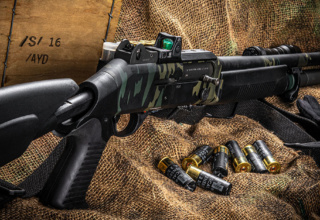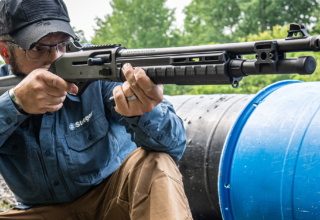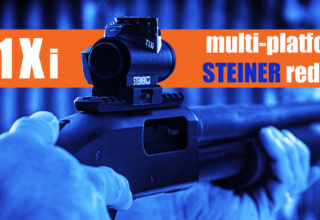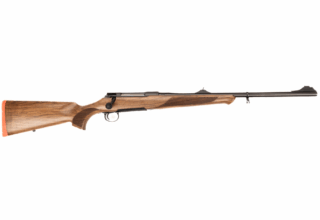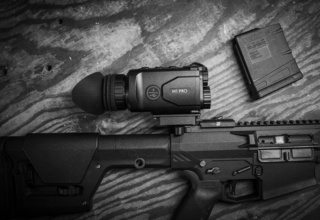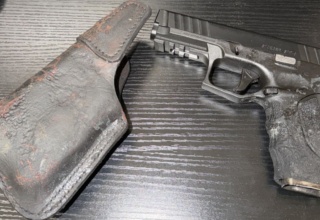The hands-free option is essential for any defensive firearm. Here’s how to set up your shotgun for optimal defensive carry.
by Rob Reaser
We see a lot of defensive shotguns decked out with all sorts of add-ons designed, theoretically, to give the shooter a tactical edge. What is too often missing from these setups is a proper sling system. And when a sling is installed, it’s usually done as an afterthought with little or no regard given to how it carries or deploys.
When we sling an AR rifle, we want it positioned across the front of the torso, making it more easily controlled and always ready to deploy. This is best achieved with the front sling swivel mount positioned to the side of the forend and the rear sling swivel mount positioned to the side of the buttstock on the side opposite the front sling mount. This configuration allows the rifle to hang “sight up/grip down” when you go hands-free, making it easy to grab and shoulder. Were the sling swivel mounts attached to the bottom of the rifle, the rifle would hang upside down — a sure recipe for awkwardness and tactical fumbling for most people.
What many folks don’t consider is that carrying a shotgun is no different. You want the firearm to hold close to the body and upright for quick deployment and comfort. Since most factory shotguns come with their sling swivel studs mounted at the bottom of the buttstock, simply attaching a sling to the factory studs is not the best solution.
Like most off-the-rack shotguns, our Mossberg 500 featured sling swivel studs mounted in the takedown screw assembly and in the bottom of the buttstock. This configuration essentially relegates sling carry to over-the-shoulder — either muzzle up or muzzle down. You can free your hands, sure, but depending on the activity, the shotgun can easily slide off the shoulder and you lose muzzle control. Carrying the gun diagonally across your back with your head through the sling solves that problem, but now it’s more difficult and slower to shoulder the weapon.
To make our shotgun carry across the front of our body, leaving hands free and the firearm ready for instant deployment, some carefully selected hardware and a bit of DIY modifying was in order. We visited Midway USA and found just what we were looking for.
For the front sling mount modification, we looked to GG&G. The company makes several sling mounting solutions for tactical firearms, and the Front Quick Detach Sling Mount Adapter for the Mossberg 500 offers the cleanest mount for use with a QD sling swivel. It offers ambidextrous mounting and is positioned between the takedown screw and the barrel’s magazine tube lug.
For the rear sling swivel mount, Noveske had the goods with their Flush Mount Push-Button Quick Detach Universal Sling Mount. This mount requires drilling a half-inch hole in your factory polymer (hollow) stock, but is the best product we’ve found for, again, a clean, unobtrusive mounting option.
Several companies make QD sling swivels in assorted sized and profiles (standard and low). Here, we tapped GrovTec for their Low-Profile Heavy-Duty Pushbutton Quick Detach Sling Swivel in 1 1/4-inch. We’ve used these swivels on several of our projects and favor them for their rugged construction.
Lastly, the sling. The options are legion, especially when you count the different styles (single-point, two-point, three-point), material construction, and manufacturers. For us, a Viking Tactics VTAC sling is almost always our first choice. They are adjustable to allow you to quickly transition between carry and deployment conditions, hold up under hard use, and are made in the U.S. For this shotgun, we chose the VTAC Padded Hybrid 2-Point Sling.
Sling Conversion…Step by Step
Always make sure the firearm is cleared of all ammunition (checking that the magazine and chamber are empty) and the safety is in the safe position. For the Mossberg 500, begin by unscrewing the takedown screw from the magazine tube and removing the barrel from the receiver.
This retainer keeps the takedown screw secured to the barrel lug when the barrel is separated from the receiver. It must be removed to install the GG&G sling mount. Do this by taking a small flathead screwdriver or similar tool and unthreading the retainer from the screw. This retainer will not be reused.
Reinstall the barrel onto the receiver. Place the swivel mount in front of the barrel lug and reinstall the takedown screw, sandwiching the mount between the barrel lug and the screw, and tighten.
The front QD sling swivel can now be installed into the mount.
Begin the rear sling mount installation by removing the butt plate. Because the retaining screws are deep inside the rubber butt pad on most shotguns, you will want to use a one-piece screwdriver for this operation. Using a screwdriver with a detachable bit could cause the bit to become stuck in the rubber pad. If that happens, you’ll have a not-fun time trying to get it out.
Examine the molding profile inside the stock. The Noveske flush-mount QD adapter requires a half-inch hole to be drilled through the polymer. We recommend placing the mount relatively high on the stock (on the opposite side of the cheek weld; right side for right-hand shooters, left side for left-hand shooters) but not so high as to interfere with the mounting screw boss.
Once you’ve established the desired position of the mount, apply a piece of masking tape to the area and trace the base of the sling swivel onto the tape. This will be the location of the hole to be drilled.
Secure the buttstock to prevent movement and carefully drill a hole using a half-inch drill bit. Be sure to stop drilling before hitting the opposite side of the stock.
Clean the hole of rough edges and raised plastic with a rounded file or a wooden dowel wrapped with fine-grit sandpaper. Do this for both the inside and outside edges of the hole, as the flush mount requires a clean, flat mounting surface.
Noveske recommends thread adhesive be applied to the flush mount threads to ensure a permanent installation. Before applying threadlocking compound, clean the threads of both mount pieces with denatured alcohol.
Install the QD cup into the stock as shown. Next, install the locking nut onto the QD cup from inside the stock. Make sure the four pointed tips on the locking nut are positioned toward the QD cup, as these will bite into the polymer. Screw the nut onto the QD cup until the point tips just touch the inside of the stock and stop.
The locking nut is drawn tight to the buttstock wall by screwing in the QD cup. To do this, install a QD sling swivel into the cup. Hold the nut into position with a 5/8-inch crescent wrench. Insert a screwdriver or similar tool through the sling swivel and rotate the sling swivel until tight. Between the sharp pointed corners of the locking nut being drawn into the polymer and the threadlocker, the flush mounted QD cup is going nowhere.
To finish, reinstall the buttplate. While not necessary, the factory sling swivel stud can be removed.
Viking Tactics provides detailed instructions on how to install the VTAC sling. It’s a simple process that begins by installing the front and rear sling QD sling swivels. Since the VTAC sling was designed to allow fast, one-handed sling adjustment with the support (non-firing) hand, the adjustment buckle is positioned toward the front of the shotgun and the padded section (if so equipped) goes toward the buttstock. The sling includes ample length to achieve a customized fit.
As you can see, the GG&G sling mount adapter combined with the Noveske flush-mount QD sling swivel cup and a VTAC sling offers a clean, comfortable, and easy to operate sling system for your defensive shotgun.
For more information and tips, check out this video on the use and application of the VTAC sling:






















